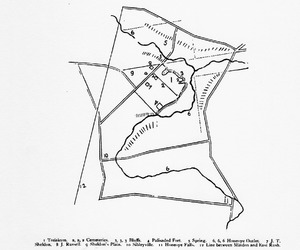Totiakton facts for kids
Totiakton was an important town of the Seneca Nation, a group of Native American people. It was located in what is now Mendon, New York. The town was found near a bend in the Honeoye Creek, about two miles from the village of Honeoye Falls. The Seneca people called their town De-yu-di-haak-doh, which means “the bend.” This name came from its location on the creek. Today, the remains of Totiakton are an archaeological site and are listed on the National Register of Historic Places. This means the site is protected because of its historical importance.
Contents
History of Totiakton
Totiakton was built on a high, flat area of land that looked like a bluff. This bluff was about 150 feet above the water. The town covered an area of about 15 acres, though some say it was 25 acres. Experts believe that as many as 4,000 people might have lived there.
Early Descriptions of the Town
In 1667, a visitor named Wentworth Greenhalgh came to Totiakton. He wrote down what he saw. He described the houses as traditional Haudenosaunee longhouses. These were very long homes where many families lived together.
Greenhalgh noted that Totiakton was on the edge of a hill. It did not have a lot of cleared land around it. The town was near the Tiotehatton River, which means ‘bending.’ This river is now known as Honeoye Creek.
He also wrote that Totiakton was about 30 miles west of another town called Canagorah. Totiakton had about 120 houses. These houses were very large. Some were 50 to 60 feet long, and others were as long as 130 or 140 feet. Each longhouse could have 13 or 14 fires inside. The people of Totiakton grew a lot of corn about a mile north of their town.
French Visitors and Missions
From 1668 to 1673, a French Jesuit mission was set up in Totiakton. It was led by a priest named Father Jacques Frémin. The Jesuits built a small chapel there. They named it La Conception, which means "The Immaculate Conception."
The famous French explorer La Salle also visited Totiakton. He came to the town twice. His first visit was in 1669, and he returned about ten years later.
Destruction and Rebuilding
In 1687, the Governor of New France, Marquis de Denonville, led an attack against the Seneca people. During this attack, he destroyed the town of Totiakton.
After the destruction, the Seneca people built a small, temporary village at the same site. This new village was much smaller, about half an acre in size. It was surrounded by a palisade, which is a fence made of strong wooden stakes. Before this, Seneca towns usually did not have palisades for defense. After a short time, the remaining people moved to a new location.
Later Ownership of the Site
In 1802, a person named Abner Sheldon bought the land where Totiakton once stood. He began to explore the site. By 1898, the farm was owned by Antoinette, who was a descendant of Sheldon, and her husband, William J. Kirkpatrick. They lived in Rochester, New York.
In 1925, Kirkpatrick sold the property to Louis Desmann. His family continued to farm the land until 1979. A large part of the property was sold to neighbors. However, 39 acres of the land were given to The Seneca Nation. This donation helped to preserve an important part of their history.



